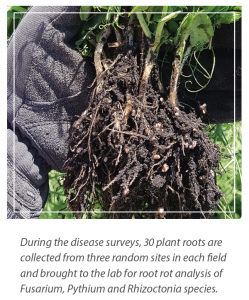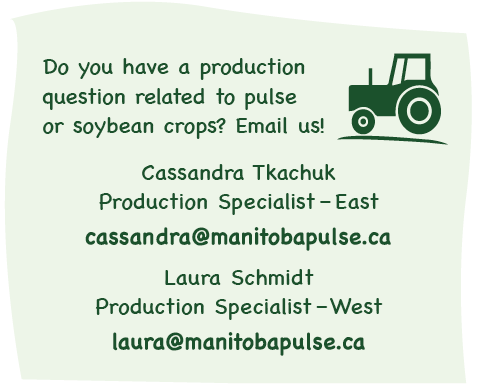Laura Schmidt, MSc, PAg, Production Specialist – West, MPSG
Summary of research by Dr. Debra McLaren and team at Agriculture and Agri-Food Canada – Brandon – Spring 2021 Pulse Beat
In 2020, 63 soybean fields, 40 dry bean fields and 46 pea fields were surveyed in Manitoba for root diseases (Table 1). COVID-19 restricted some surveillance and testing capacity in the province in 2020, but for the most part we were able to capture a pretty clear picture of what happened in terms of pulse and soybean root diseases.
MPSG staff personally hopped into 56 of those fields to collect samples. Soybeans were sampled from mid-August to early September, dry beans were sampled in late July and peas were sampled in late June and mid-July.
The clear picture that emerged from 2020 was that Fusarium root rot continues to be our most prevalent disease infecting soybean, dry bean and pea roots (Table 1). Compared to 2019, the severity of Fusarium infections rose in soybeans and peas, from 4.3 to 5.0 and 2.9 to 3.7, respectively, and was consistent in dry beans, moving from 3.8 in 2019 to 4.0 in 2020 (Table 2). This increased root rot severity from 2019 to 2020 can largely be attributed to more moisture in 2020.
Severity of root rot infection typically reflects soil moisture conditions of a given year. For example, take a look at 2016 in Table 2. Soybeans and dry beans recorded the highest severities, hitting 5.5 and 5.6, respectively. Peas were an enigma that year at an average rating of 2.8. Following it up in 2017 with drier conditions, we did not see those high severity levels maintained in soybeans and dry beans.
In our disease severity scale for soybeans and pulses, 4.0 represents the threshold past which we anticipate root rots have had a detrimental effect on yield. A root rot severity rating of 4.0 represents when symptoms were present on half of the root systems and plants had visible stunting.
For soybeans, 95% of fields in 2020 had average severity ratings above 4.0. In dry beans and peas, this proportion above 4.0 was 43 and 41%, respectively. Compare this to 2019, where 60% of soybean fields, 35% of dry bean fields and only 9% of pea fields were above 4.0.
Phytophthora root rot was not detected in any of the 68 soybean samples sent in from Manitoba in 2020. Rhizoctonia and Pythium root rots were also absent in the 2020 survey. The last two years have been quiet for Phytophthora, when previously we’ve typically found around a third of soybean crops infected with this disease.
Unfortunately, we were not able to get a beat on Aphanomyces in 2020 due to COVID-19. In previous years, Aphanomyces was found in 83% of pea fields sampled in 2019, 56% in 2018, 47% in 2017 and 77% in 2016.
It’s important for pea growers to keep this disease in mind when planning rotations, and especially important that we keep monitoring for this silent yield robber. Aphanomyces oospores persist for a long time in the soil and will reproduce on other host species like alfalfa, dry beans, clover, lentils, vetches and several weed species.
Keep an eye on yellow patches in low-lying areas of the field, or in areas where water accumulates, and consider getting these areas tested for Aphanomyces. Or, consider signing up for the annual pulse and soybean disease surveys by contacting one of MPSG’s Production Specialists: Laura (West) or Cassandra (East).



